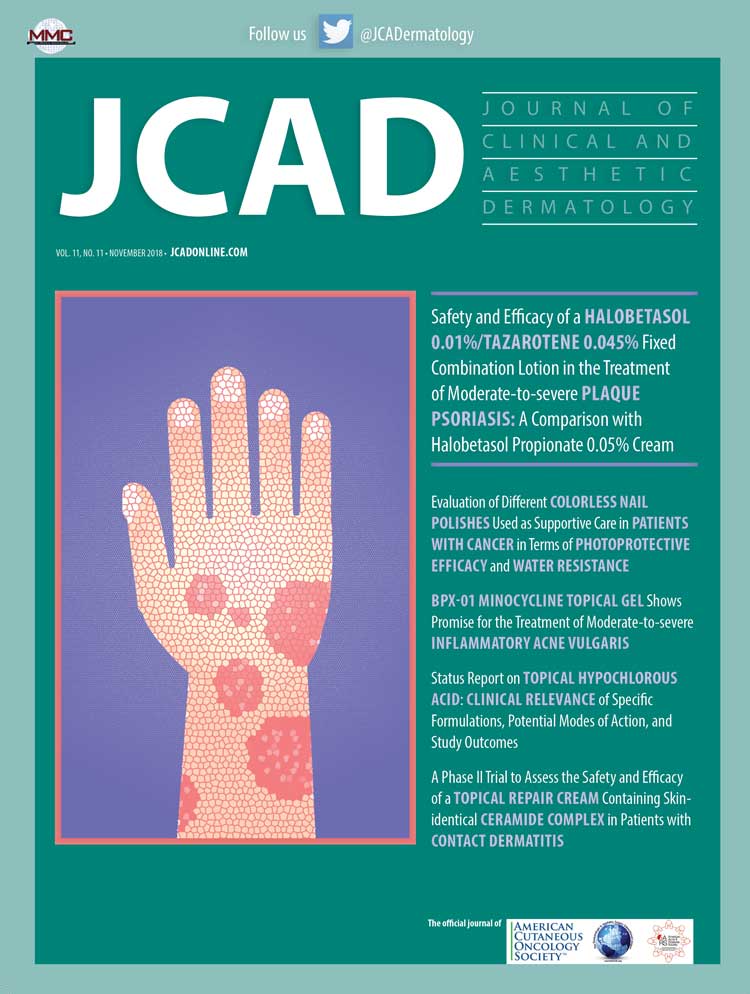 VOL. 11, NO. 11
VOL. 11, NO. 11
Dear Colleagues:
Welcome to the November 2018 issue of The Journal of Clinical and Aesthetic Dermatology. We kick off the issue with a multicenter, randomized, double-blind, parallel-group, vehicle-controlled Phase II study titled, “Safety and Efficacy of a Halobetasol 0.01%/Tazarotene 0.045% Fixed Combination Lotion in the Treatment of Moderate-to-severe Plaque Psoriasis: A Comparison with Halobetasol Propionate 0.05% Cream.” Here, Bhatia et al randomized patients (N=154) to HP 0.01%/TAZ 0.045% lotion, halobetasol propionate 0.05% cream, or vehicle with the instructions to apply topically once daily for two weeks. The authors report that HP/TAZ lotion was significantly more effective than vehicle and was comparable to halobetasol propionate 0.05% cream in reducing erythema, plaque elevation, and scaling. Limitations of the study were 1) it was label-restricted to two weeks and 2) there was no follow-up post-treatment to further evaluate the benefits of including tazarotene in the combination.
Next, Couteau et al report the results of their study titled, “Evaluation of Different Colorless Nail Polishes Used as Supportive Care in Patients with Cancer in Terms of Photoprotective Efficacy and Water Resistance.” Here, the investigators, using an in-vitro study model, examined the photoprotective effects of 12 different clear nail polishes as a method to prevent the adverse effects that chemotherapy can have on the nails of patients. After applying two layers of each polish to polymethyl methacrylate (PMMA) plates, the authors measured ultraviolet (UV) B and UVA sun protection factor (SPF) and water resistance. The authors observed that some of the colorless nail polishes were able to provide some degree of photoprotection, with SPF values as high as 180; however, these values are still much lower than those achieved with colored nail polish. They also observed that all but one of the products tested were water-resistant. The authors concluded that two layers of the tested colorless polishes, in particula Mavala 6 Osaka and Vitry CC bleaching base with silicium for yellow nails) applied to the nails of people undergoing chemotherapy can help protect the nails from the adverse effects that can occur during treatment. The authors also conclude that the vehicles used in each formulation play an important role in a product’s photoprotective efficiency and water resistance.
Following this, Alexis et al describe outcomes of two randomized, vehicle-controlled trials (Phases IIa and IIb) in their article titled, “BPX-01 Minocycline Topical Gel Shows Promise for the Treatment of Moderate-to-severe Inflammatory Acne Vulgaris.” In Study 1, investigators at a single center randomized 33 subjects with highly fluorescing facial skin to either BPX-01 1% or vehicle control once-daily treatment for four weeks. Changes in Propionibacterium acnes (P. acnes) cultures were assessed by subjects and the investigator. In Study 2, investigators from 15 centers randomized 226 subjects with moderate-to-severe, inflammatory, non-nodular acne to treatment with BPX-01 1%, BPX-01 2%, or vehicle control, once-daily for 12 weeks. Here, reduction in the number of inflammatory lesions was the primary endpoint. Both studies measured tolerability and safety. In Study 1, the authors observed a 90.9-percent reduction in P. acnes colonization among the BPX-01 group, compared with the vehicle control group (65.53%; p=0.020). In Study 2, the authors observed a 58.5-percent reduction in the number of inflammatory lesions among the BPX-01 2% group, whereas a reduction of 43.8 percent was observed in the vehicle control group. According to the authors, these observations indicate that BPX-01 has a similar effectiveness profile for reduction of inflammatory (non-nodular) acne lesions as oral minocycline formulations, concluding that BPX-01 2% shows promise as a treatment for moderate-to-severe, non-nodular, inflammatory acne vulgaris. Additionally, the authors postulate that because BPX-01 is a topical formulation, there is less chance for adverse events, which have been associated with oral minocycline.
Next, in a review by Del Rosso and Bhatia titled, “Status Report on Topical Hypochlorous Acid: Clinical Relevance of Specific Formulations, Potential Modes of Action, and Study Outcomes,” the authors summarize relevant study outcomes and potential modes of action related to a core hypochlorous acid (HOCl) formulation utilized in the treatment of various skin disorders. The authors report that physiochemical properties of HOCl after application to skin are highly dependent on both pH and formulation stability. They describe the core HOCI formulation’s ready-to-use vehicles that are approved and available for topical application and have been shown to be stable, noncytotoxic, and pH-neutralized to augment therapeutic activity and skin tolerability.
And finally, in the article titled, “A Phase II Trial to Assess the Safety and Efficacy of a Topical Repair Cream Containing Skin-identical Ceramide Complex in Patients with Contact Dermatitis,” Yazdanparast et al report the findings of their study that included 15 adult patients with contact dermatitis who were instructed to apply a skin-identical ceramide complex cream to a specified area of dermatitis at least three times a day for four weeks. The authors then assessed several biophysical parameters, as well as Physician Global Assessment (PGA) scores and Three-item Severity (TIS) scores, at baseline, Week 2, and Week 4 of the study. Overall, the authors observed a decrease in TIS and an increase in skin hydration among their patient sample, suggesting repair of the skin barrier occurred. Limitations include small sample size and lack of a control vehicle.
We hope you enjoy this issue of JCAD, and as always we welcome your feedback and submissions.
With regards,
James Q. Del Rosso, DO, FAOCD—Editor-in-Chief, Clinical Dermatology
Wm. Philip Werschler, MD, FAAD, FAACS—Editor-in-Chief, Aesthetic Dermatology
Seemal R. Desai, MD, FAAD—Associate Editor

